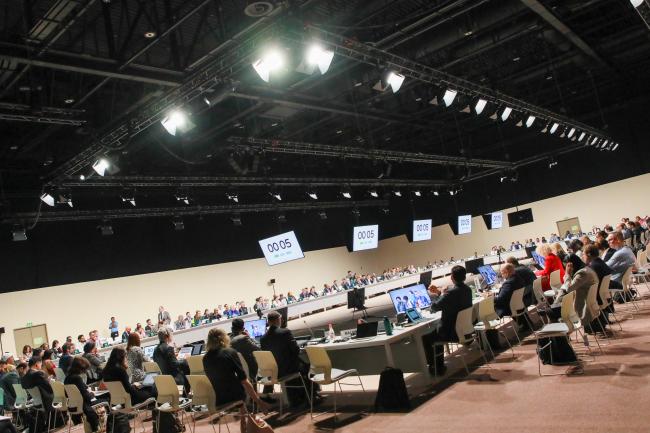COP28’s historic agreement, and the pursuit of climate justice

From flooding in Pakistan, wildfires in California, sea-level rise threatening Vanuatu, to Europe’s recent heatwaves, the global impacts of climate change have become increasingly apparent in recent years.
In climate advocacy and policy, these impacts of climate change are referred to as ‘loss and damage’ – whereby lives, cultures, livelihoods, and infrastructure are irretrievably lost, or significantly damaged, by weather events which would not have happened without human-induced climate change.
Anywhere in the world can experience ‘loss and damage’ due to climate change, but it is countries in the Global South, particularly Small Island Developing States (SIDS), who experience losses and damages most significantly. These countries are both most exposed to hazards caused by climate change, and least able to cope with them.

Misbahul Aulia, via Unsplash
Yet these very countries hold the least historical responsibility for greenhouse gas emissions, having burned a fraction of the fossil fuels responsible for anthropogenic climate change. One paper suggests that the world’s most industrialised countries are responsible for 90% of historical greenhouse gas emissions. Moreover, histories of colonisation and underdevelopment by the Global North have partly created the Global South’s vulnerability to climate change, stymying their development hence resilience to hazards.
So, at the heart of Loss and Damage from climate change lies an injustice: those least responsible for climate change face the greatest vulnerability to it, and are least able to cope with its extreme and slow-onset impacts.
Trust, solidarity, and climate justice
The Association of Small Island States (AOSIS) first called for the Global North to give financial ‘compensation’ for losses and damages experienced by SIDS in 1991. Activism by climate-vulnerable countries in the Global South has since become increasingly powerful, calling for the Global North to provide financial and technical support for responding to climatic disasters. In one iconic example, Tuvalu’s Foreign Minister addressed COP26 in Glasgow as he stood knee-deep in sea water, emphasising the existential threat posed by loss and damage to the Pacific nation.

"Anyone seen Loss and Damage at COP21? event by FoE" by John Englart (Takver) is licensed under CC BY-SA 2.0.
This advocacy by climate-vulnerable countries, paired with the increasingly tragic manifestations of climate change, has led to emerging governance arrangements for Loss and Damage. [Note that Loss and Damage is capitalised when referring to the subject of climate negotiations – covering issues like financial and technical support given by the Global North to the Global South – and kept lower-case when referring to experiences of losses and damages from climate change.] Last year, COP27 secured the biggest development on L&D yet, establishing a dedicated Loss and Damage Fund. The terms for the operationalisation of this L&D Fund were agreed earlier this week, on the first day of COP28.
Whilst celebrated as a historic victory, the new L&D Fund contains significant compromises which constrain its scope for delivering climate justice. Like the Paris Agreement, the L&D Fund explicitly excludes any ideas of the Global North’s ‘liability’ for climate change. The L&D Fund also does not have a funding target, nor does it tie the Global North to any requirement to pay.

Despite the tentative success of operationalising the L&D Fund, many negotiators from the Global South continue to express concern about these compromises. Summarising the L&D Fund after the first day of COP28, Mohamed Adow, the Director of Power Shift Africa, said: "It's great to see the Loss and Damage Fund established…[It] shows how this UN process can act quickly when countries work together…[Nonetheless,] initial funding pledges are clearly inadequate & will be a drop in the ocean compared the scale of the need they are to address."
Where does L&D go now?
The past two years have undoubtedly seen historic progress on L&D – even in 2021, many negotiators regarded a dedicated L&D Fund as near-impossible. The agreement of the L&D Fund governance arrangements on COP28’s first day signals Parties’ desire to show commitment to the issue. Indeed, the announcement of operationalising the L&D Fund was met with smiles, kisses, and a standing ovation at COP28.
Yet to push towards climate justice, Global South negotiators are clear that L&D funding needs to be rapid and plentiful. They have called for $100 billion a year in L&D funding by 2030, which still falls short of the hundreds of billions in projected loss and damage over coming years (and does not even begin to address non-quantifiable losses like wellbeing, cultures, and languages). With the Global North yet to commit to any mandatory minimum contributions to the L&D Fund and ignoring G77 criticism of the World Bank host, the L&D fund (so far) has a shaky foundation for delivering climate justice.
L&D needs to have trust, solidarity, and climate justice at its heart. This can only be achieved by prioritising and entrenching the perspectives of countries, peoples, and communities most-impacted by climate change in L&D governing arrangements.
As it stands, however, the L&D Fund still bears the marks of the fragility of trust and solidarity between the countries of the Global North and South in climate negotiations.
This blog post was written by Catriona Flesher, postgraduate researcher in the School of Law.
